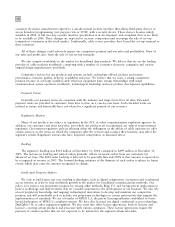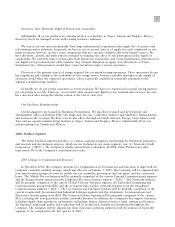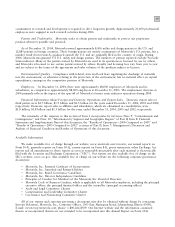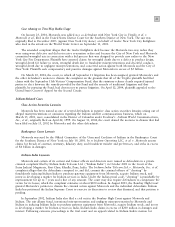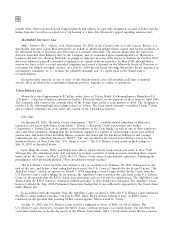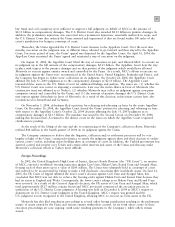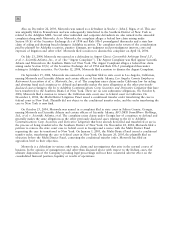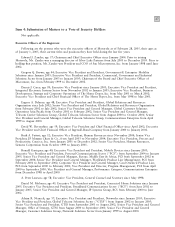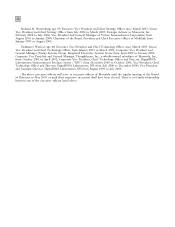Motorola 2004 Annual Report Download - page 28
Download and view the complete annual report
Please find page 28 of the 2004 Motorola annual report below. You can navigate through the pages in the report by either clicking on the pages listed below, or by using the keyword search tool below to find specific information within the annual report.
20
Item 2: Properties
Motorola's principal executive oÇces are located at 1303 East Algonquin Road, Schaumburg, Illinois 60196.
Motorola also operates manufacturing facilities and sales oÇces in other U.S. locations and in many other countries.
(See ""Item 1: Business'' for information regarding the location of the principal manufacturing facilities for each of
Motorola's business segments.) Motorola owns 55 facilities (manufacturing, sales, service and oÇce), 31 of which
are located in North America and 24 of which are located in other countries. Motorola leases 295 facilities, 118 of
which are located in North America and 177 of which are located in other countries.
As compared to 2003, the number of facilities owned or leased was reduced primarily because of the spin-oÅ
of Freescale Semiconductor, the entity comprised of Motorola's former semiconductor operations, during 2004. In
addition, as part of Motorola's overall strategy to reduce operating costs and improve the Ñnancial performance of
the corporation, a number of businesses and facilities have either been sold or are currently for sale. During 2004,
facilities in Tempe, Arizona; Northbrook, Illinois; Mesa, Arizona; and Swindon, England were sold. A facility in
Harvard, Illinois is currently up for sale.
Motorola generally considers the productive capacity of the plants operated by each of its business segments to
be adequate and suÇcient for the requirements of each business group. The extent of utilization of such
manufacturing facilities varies from plant to plant and from time to time during the year.
A substantial portion of Motorola's products are manufactured in Asia, primarily China, either in our own
facilities or in the facilities of others who manufacture and assemble products for Motorola. If manufacturing in
the region was disrupted, Motorola's overall productive capacity could be signiÑcantly reduced.
Item 3: Legal Proceedings
Personal Injury Cases
Cases relating to Wireless Telephone Usage
Motorola has been a defendant in several cases arising out of its manufacture and sale of wireless telephones.
Jerald P. Busse, et al. v. Motorola, Inc. et al., Ñled October 26, 1995 in the Circuit Court of Cook County, Illinois,
is a class action alleging the defendants have failed to adequately warn consumers of the alleged dangers of cellular
telephones and challenging ongoing safety studies as invasions of privacy. The Circuit Court entered summary
judgment in defendants' favor in 2002. In June 2004, the Illinois Appellate Court aÇrmed the summary judgment
and dismissal of the case. In January 2005, the Illinois Supreme Court denied plaintiÅs' Petition for Leave to
Appeal.
During 2001, the Judicial Panel on Multidistrict Litigation transferred Ñve cases, Naquin, et al., v. Nokia
Mobile Phones, et al., Pinney and Colonell v. Nokia, Inc., et al., Gillian et al., v. Nokia, Inc., et al., Farina v.
Nokia, Inc., et al., and Gimpelson v. Nokia Inc, et. al., which allege that the failure to incorporate a remote
headset into cellular phones rendered the phones defective and that cellular phones cause undisclosed injury to cells
and other health risks, to the United States District Court for the District of Maryland for coordinated or
consolidated pretrial proceedings in the matter called In re Wireless Telephone Radio Frequency Emissions
Products Liability Litigation. On March 5, 2003, the MDL Court dismissed with prejudice, on federal preemption
grounds, the Ñve cases. PlaintiÅs appealed to the United States Court of Appeals for the Fourth Circuit; the appeal
has been briefed and argued, but no decision has been announced.
During 2002, the MDL panel transferred and consolidated six additional cases, Murray v. Motorola, Inc.,
et al., Agro et. al., v. Motorola, Inc., et al., Cochran et. al., v. Audiovox Corporation, et al., SchoÑeld et al., v.
Matsushita Electric Corporation of America, et al., each of which alleges that use of a cellular phone caused a
malignant brain tumor, Dahlgren v. Motorola, Inc., et al., which alleges that defendants manufactured and sold cell
phones that increase the risk of adverse cellular reaction and or cellular dysfunction and failed to disclose biological
eÅects, and Brower v. Motorola, Inc., et al., which contains allegations similar to Murray and Dahlgren, with the
MDL Proceeding. On July 19, 2004, the District Court for the District of Maryland found that there was no federal
court jurisdiction over Murray, Agro, Cochran and SchoÑeld and remanded those cases to the Superior Court for
the District of Columbia. On November 30, 2004, defendants moved to dismiss the Murray, Agro, Cochran and
SchoÑeld complaints.








